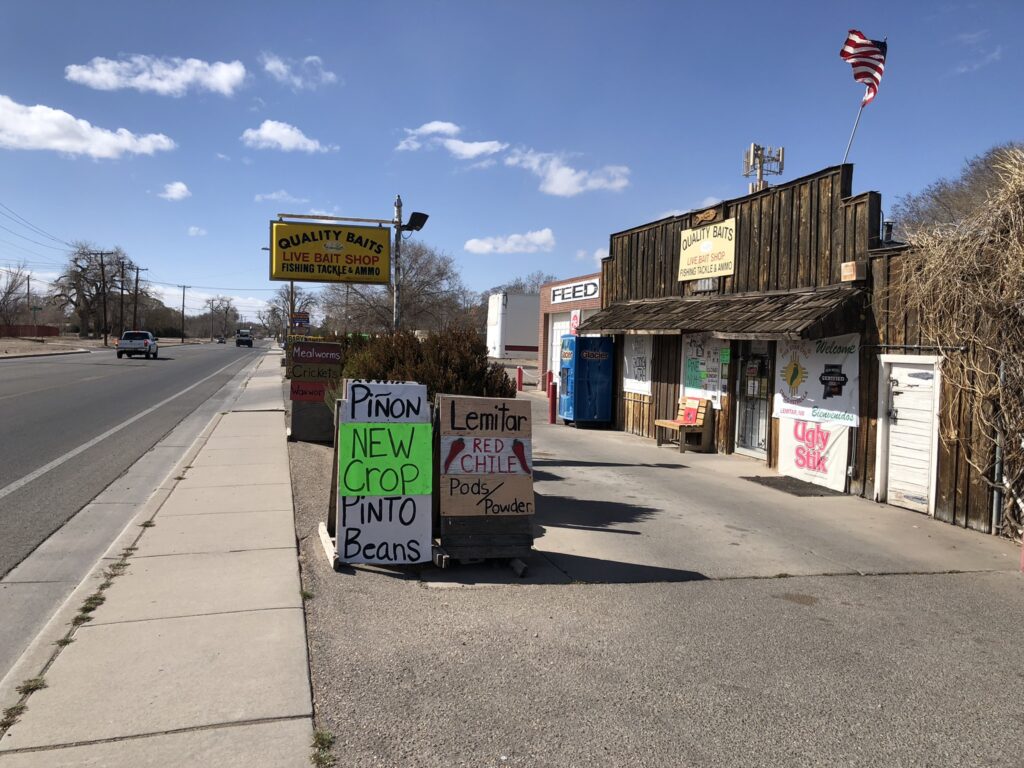
pinto beans in Albuquerque’s South Valley
Unfortunately Quality Baits was closed when we passed on our Sunday morning bike ride, which is too bad.
They have pinto beans.
For the new book, I’m trying to get my head around Albuquerque in 1918. For reasons I don’t yet fully understand, pinto beans were a very big deal in 1918.
Albuquerque’s Chamber of Commerce that year was leading the pinto bean charge. From the Albuquerque Morning Journal, June 10, 1918:
“Beans and drainage are the two best bets in New Mexico today,” is the opinion which is being freely expressed by many local business men and land owners. The present time is believe to be a crucial one for the bean grower.
Beans have been a part of New Mexico’s agricultural heritage from time immemorial, a crop native to North America that played an central role in the subsistence farming of indigenous communities. But the Chamber of Commerce in 1918 wasn’t talking about growing food to eat here. They were trying to hitch Albuquerque’s economic future to pinto beans as an export crop.
You can understand their enthusiasm, given the general awesomeness of pinto beans.
Their scheme for sharing this enthusiasm to economic ends was postcards. The Albuquerque Chamber of Commerce was going to work with the federal government, which would produce postcards about the awesomeness of pinto beans, which Albuquerque residents would send to their families back east. From the Feb. 20, 1918 Albuquerque Morning Journal:
“A two-cent stamp on such a postcard would make more pinto-converts in the east than two dollars spent in ordinary impersonal advertising,” said Secretary Aldo Leopold of the Chamber of Commerce yesterday. “It would also remind the New Mexico citizen that charity begins at home, and that if he does not eat pintos he is neglecting an opportunity to benefit both himself and his state.”
Yes, that Aldo Leopold. 1918 was the year he, as secretary of the Albuquerque Chamber of Commerce, organized a conference on the issue of drainage of the land on Albuquerque’s valley floor. High water tables and swampy land have always been a problem here, but it was getting worse. Drainage was the fix, and the rhetoric of the day suggested that with drainage New Mexico’s Middle Rio Grande Valley could be richly agriculturally productive – not in the traditional subsistence ways long practiced in the valley, but with export crops.
I’m a little unclear on whether the postcard scheme was actually implemented – I found later references to a distribution of stickers. More work needed. But what’s interesting is where pinto beans fit into the long, circuitous history of agriculture in the New Mexico’s Middle Rio Grande Valley.
The list of crops touted as the valley’s agricultural future is long – sugar beets, pinto beans, large-scale wheat, tomatoes, even tobacco. All failed.
In the 1919 agricultural census, we can see a pattern that very closely matches what we see in the valley today: more than 3,000 acres of alfalfa, just 134 of beans in Bernalillo County. People have tried lots of things, but alfalfa has always been the main crop that really works here.
What’s interesting to me here is not so much the failure of pinto beans as a middle valley crop. It’s Leopold. He’d left Albuquerque by the time the Middle Rio Grande Conservancy District began digging the ditches through the valley’s lowlands that provide drainage even today. But his mark on that crucial process, so important in making Albuquerque the city it is today, remains profound.
The thing that’s most interesting, and that became a central piece of the work that brough him such renown, is the sense of civic responsibility, of collective action for the common good. That’s why I love the postcards (or stickers?) and the argument behind them.
Aldo seems to have practice what he preached. His charmingly meticulous 1920 garden plan for the family home on 14th St. SE here in Albuquerque includes “beans”, over near the cabbage, lettuce, and beets.
Not sure if they were pintos.

Quality Baits: Come for the pinto beans, stay for the mealworms. A true South Valley institution.
I grow a large number of bean varieties and also cross-breed them and work on new varieties. 🙂
Bean talk is always interesting to me.
I’m really not sure what is going on with pinto beans out there now. I know for myself that I’ve grown pinto beans here (mid-Michigan) and sometimes they do ok, but other times not. I have a local climate which is not great for dry bean production some years (too much wet weather later in the summer, fogs, heavy dewfalls) but also the heat can get higher plus our soils here on this lot are mostly clay. Also with how the weather has been changing so much with such extremes what I’ve been doing is trying to breed smaller beans that finish quicker. This way I can get multiple plantings in if I have the space but also it gives me a much better chance of success. Pinto beans being a larger bean means they may not finish as reliably as some others I’ve come across.
if you want to see bean pics and me rambling on about beans (in a rather unorganized fashion) you can check out my own website and bean page at http://www.anthive.com/project/beans/